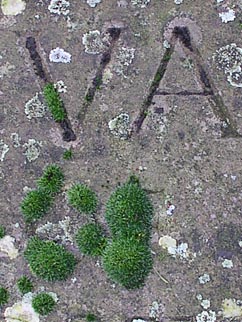A converted schoolhouse and a small sign pointing down a drive is the only indication you get of the existence of St Mary. We were driving along in a cold drizzle, and missed it the first time. St Mary is definitely an estate church, and it sits in the middle of the estate of Longstowe Hall, surrounded on three sides by fields and on the fourth by the gardens. It's a fine place for a church, and a fine churchyard: a little moat surrounds it, and there is a magnificent cedar dwarfing the west tower and spreading its canopy over the lich gate.
Sadly, St Mary doesn't live up to its location. First, it was locked, and there was no information about keyholders. Second, save for the 14th century tower it was rebuilt in 1864-5. I've not seen inside it, so I don't want to jump to conclusions. I've seen very fine Victorian churches, and very dull medieval ones. However, the window tracery didn't fill me with great hope. I had a look inside the porch, and the red and blue brick doorway ('I know, let's make it look like a North London police station!') made me shudder. Still, it would have been nice to see inside. I might have been proved to be the most appalling philistine, after all. Also, Pevsner talks about a couple of interesting monuments: particularly that of Sir Ralph Bovey, who died in 1679 and is shown rising, naked, 'waist high from the ocean, grasping a wooden anchor let down by the hand of Christ from white clouds'. Ridiculous, but unusual.
Without getting inside, what is there to say? I must confess that I liked the tower. The west face in particular is full of character - it has a Perpendicular window in the base and then two slit-windows in the middle stage and the bell-stage. None of these match up, which makes the whole thing look a bit lopsided. It has diagonal buttresses and a neat little base course, and looks as though it might have been placed on the grass as part of a gigantic game of chess. Certainly, it is far too pretty to be associated with the rest of the church.
The reason the tower really caught my attention, though, was the stone it was built from. It's unusual for any tower in Cambridgeshire to be built from stone, of course, but this isn't pale clunch, or crisply carved Barnack stone. St Mary's tower is built of a reddish-brown stone that I have grown up knowing as carstone. It is familiar from the area around Hunstanton in North-west Norfolk, where it is one of the main building materials. My Dad grew up there, and while my grandmother was still alive we used to go and spend summer holidays on the beach, making castles and walking miles over the muddy sand to reach the sea.
When I wasn't constructing elaborate defences or making my long-suffering parents play rounders, I used to go and look for fossils in the cliffs. Hunstanton was a wonderful place for a budding geologist. The cliffs are divided into three distinct layers - white chalk on top, red chalk in the middle and then the brown carstone at the base that crumbled when you scraped it, and used to stain like rust. I never found any fossils (though carstone is apparently rather full of them) but the cliffs inspired an awe at the scale and power of geological forces that has never really gone away.
Both Hunstanton and Longstowe sit on the line where this layer of rock reaches the surface. The line runs down the eastern side of the Wash and then curves round to the south-west, marking the place where the Chilterns descend to the great plains of the Ouse and Nene. Around Oxfordshire and Wiltshire it sinks below the surface, but resurfaces on the Isle of Wight and on the crest of the North Downs. This is the Lower Greensand, and it was laid down in the first half of the Cretaceous Period, between 144 and 100 million years ago. Megalosaurs would have been hunting the iguanodons of Dorset in those days, and the shallow seas here would have been full of ammonites.
Sadly, there were no ammonites in the tower of St Mary, and if there were any iguanodons they had evidently decidedly to keep out of the rain. Still, it is exciting to see geology writ large on the landscape, and still more exciting to see it in the fragile productions of our own hands. The church may not be up to much, but one day it will have been washed to the sea by countless centuries of February drizzle, to be made into layers of rock that no human will ever see.
St Mary was locked, and there were no keyholders listed.


